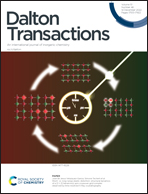Ultrathin NiCo-LDH regulated by CuNiCo trimetallic spinel sulfides as highly active and stable electrocatalysts for overall water splitting†
Abstract
The rational design of heterostructures, including the synthesis of candidate materials and the construction of structures, is particularly important for the activities of electrocatalysts. Herein, a unique heterostructure of ultrathin NiCo-LDH wrapped CuNiCo trimetallic spinel sulfides was constructed via facile hydrothermal and electrodeposition processes. Due to the ultrathin NiCo-LDH layer, the change in the local electronic structure resulting from the interaction of two components can be effectively transferred to the surface of electrocatalysts, which was verified by XPS tests. The heterostructure exhibits excellent activity and stability as efficient bifunctional electrocatalysts for overall water splitting. The corresponding overpotentials are 270 mV at 50 mA cm−2 for the oxygen evolution reaction (OER), and 93 mV at 10 mA cm−2 for the hydrogen evolution reaction (HER) in 1.0 M KOH, respectively. It is noteworthy that the OER activity exceeds that of RuO2. Meanwhile, the heterostructure presents excellent stability for more than 40 hours. The outstanding performance is attributed to the surface electronic structure of NiCo-LDH optimized by highly conductive and stable CuNiCo trimetallic spinel sulfides. The results confirm that it is an effective strategy to tune the catalytic performance by constructing a heterostructure with an ultrathin surface layer.



 Please wait while we load your content...
Please wait while we load your content...